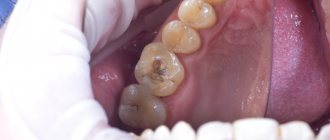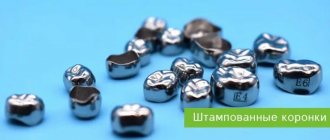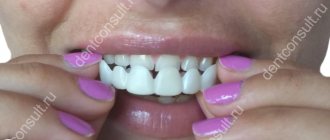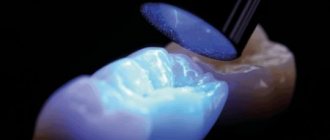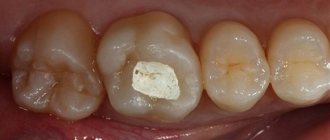Dental filling is one of the most popular services in modern dentistry. Naturally, the need to put a filling on a tooth arises for a reason: filling is carried out to restore dental units destroyed by caries, in the treatment of pulpitis and periodontitis. Putting a filling on a damaged tooth is necessary not only to close an unsightly and noticeable carious cavity. Fillings placed correctly and with high quality completely restore the aesthetics and function of the tooth.
When treating teeth, dentists can use a variety of types of fillings, but one of the most modern options is light fillings on the tooth. In the article we will tell you in detail about when you need to put a light filling on a tooth, what are the advantages and features of this type of filling material, how light fillings for chewing and front teeth differ, and also consider the prices for the service in Moscow.
Calculate the cost of treatment by taking a short test in 20 seconds!
Do not delay your treatment, because in this matter time plays against us.
Content:
- Types of light fillings
- Distinctive features of the coating
- What does dental photopolymer consist of?
- Indications for installation
- Pros and cons of photopolymer “tabs”
- How to install a light seal
- Use in pediatric dentistry
- How long do they serve?
To close a carious cavity and restore aesthetics and functionality to a tooth, dentists use different filling materials.
These compounds are constantly being improved to make them more reliable, durable and easier to use. Recently, doctors are increasingly placing light fillings. They have an acceptable cost and fit as tightly as possible to the walls of the unit. They can be used both in the treatment of caries and to eliminate chips and depressions resulting from traumatic injuries to the jaw.
The main feature of light-curing fillings is that they harden exclusively under the influence of a blue lamp. This allows specialists to carry out all treatment measures without unnecessary haste and as carefully as possible. After all, the risk that the material will harden ahead of time, when the surface of the crown to be filled has not yet acquired sufficient aesthetics, is completely absent.
What does the cost depend on?
- Manufacturer and country of manufacture of the polymer material.
- Degree of tooth decay: the most carious tooth needs more restoration.
- Clinic level.
- Material and equipment used.
- Tooth location (front ones will cost more, as they require more aesthetic work)
- Doctor's qualifications.
It is worth remembering that the installation of a filling is preceded by treatment, which, as a rule, is paid for separately. It includes anesthesia and canal cleaning.
Types of light fillings
The classification is based on the installation area. Teeth located in the smile zone require a more careful approach. Beauty comes to the fore during treatment. To solve this problem, doctors take a light-hardening material intended for application to the frontal zone. It consists of a finely dispersed light composite, that is, it includes small particles and has a complex composition.
There are reflective fillings for the chewing area. They contain larger light polymers, which allow the molars to chew food as actively as they did before treatment.
Distinctive features of the coating
When talking about this dental material, it is necessary to emphasize that it:
- It hardens only when treated with a special medical lamp , while ordinary fillings become hard as a result of a chemical reaction that occurs between their components and oxygen from the air. The bonds formed during the processing of the liquid photopolymer composition are much stronger. This means that the light “tab” will exactly repeat the shape of the carious “hollow”. There will be no gaps or microcracks between it and the walls of the tooth in which microorganisms could multiply. All this together significantly extends the service life of the material.
- May be of different shades. Therefore, the dentist has the opportunity to make a destroyed fang, molar or incisor beautiful, almost indistinguishable from its neighbors. The ability to match colors is very important when working with front units.
The truth about photopolymer fillings
With this article, on a seemingly simple topic, I will shock someone, surprise someone, and upset someone. But I believe that everyone, both dentists and patients, has the right to know the truth about composites that I want to tell.
Moreover, as one of my recent articles about veneers and comments on it showed, not only patients, but also most doctors do not know about the properties of composite materials for dentistry.
It's no secret that all dental clinics, without exception, install photopolymer fillings and make composite restorations. And this is considered the gold standard of therapeutic dentistry not only in Russia, but throughout the world.
These are the best, most beautiful fillings - they are matched to the color of the teeth. There is no better way to fill teeth today. But! Few people know about the properties of composite materials. But it would be worth...
We all know, and no one will argue with this, that composite materials are simply modified plastic. They differ only in the method of polymerization. Some harden when exposed to light, others when mixed, some have double polymerization. But only a few know that these materials are harmful to humans.
More than 10 years ago, a German dental scientist spoke at a general medical congress in Europe with the results of his many years of scientific research. His report focused on high-tech dental composite materials. And about the best, the most perfect!
He studied dental photopolymer composites from the point of view of biocompatibility with the human body. And the results of his research shocked everyone. It turned out that all dental composites, without exception, are an ideal environment for the proliferation of microorganisms.
If you explain it in a language understandable to the average person, this research looked like this.
Dental photopolymer composites are taken. They are polymerized by a lamp or by technicians using special equipment at a certain temperature. Ideally polymerized, polished, these materials are placed in a Petri dish in a thermostat, and the growth of microorganisms is observed. So, in any dental composite, microorganisms grow and multiply just fine. Moreover, for some types of microorganisms the composite is also food.
What do we get in the oral cavity after placing a filling?
Actually the same thing. The oral cavity is an ideal thermostat. It's always warm there: the temperature is from 36 to 37 degrees. It's always a humid environment there. And you can’t even imagine a better place for the spread of microorganisms than the oral cavity!
Any practitioner who has worked with a chair for several years knows perfectly well that when removing a composite restoration that has stood for 4-5 years, in almost 100% of cases we will find some kind of pigment or secondary caries underneath it - changes will almost certainly be made!
If we remove an amalgam filling that has stood for even 25-30 years (this also happens), then everything underneath is clean, everything is great.
Under the cement filling, under the usual phosphate cement that is used to fix the crowns, everything is also clean and perfect.
Under the composite material, under the layer of plastic, everything will definitely be dirty and black. Any practical dentist will tell you this.
It turns out the secret is that you can’t even imagine a better environment for the proliferation of microbes in the oral cavity than composite plastic!
But no one is in a hurry to disseminate these data in wide dental circles. Why? After all, this study can easily be checked and confirmed by any graduate student at a medical university.
The answer is simple. We understand perfectly well that despite the fact that photopolymer composites are harmful, there is simply nothing to replace them at the current level of development of dentistry!
Of course, theoretically they can be replaced. You can also put gold inlays or amalgam fillings on your chewing teeth. What about the front teeth?
An ideal alternative is porcelain veneers. But this option is acceptable when it comes to a large restoration (by the way, veneers are also usually fixed with a composite). And when there is a small filling, or a small chip in the enamel, what should you do? There is only one option - composite!
Whether we like it or not, real data on dental materials, including composites, is kept silent. And among practical doctors they are known only to a few. Why?
When it comes to dental fillings, 90% of doctors attend commercial, advertising training courses organized by companies that produce and sell dental materials. Doctors will be shown “serious” scientific research conducted at European universities, commissioned by the manufacturer. There they will hear about the strength, elasticity, optical qualities of the advertised material, but not a word about biocompatibility.
Now imagine: will a company advertising a photopolymer material talk about the disadvantages of composites? Of course not. On the contrary, they will tell you advertising fairy tales that everything is fine, everything is wonderful. I have personally heard that in advertising courses they give examples that some parts of spaceships consist of a composite. Yes, it is possible, but there is no need for biocompatibility. Nobody will tell you about this!!!
But there are scientific studies that you can’t argue with.
By the way, this medical congress, at which the “terrible” truth was revealed but not widely publicized, is not the only one!
I had the opportunity to attend many major conferences and congresses. I especially remember the speech of a very famous physicist in scientific circles at one of these conferences at the Russian Academy of Sciences.
In his report, he spoke about the dangers of mobile phone radiation for human health. The results of his laboratory's research showed that mobile phones pose a mortal danger to people: they cause destruction of brain tissue and can lead to cancer.
Moreover, his conclusions were not unfounded: serious scientific research was carried out for more than 5 years, and a large amount of irrefutable evidence was collected.
Such a statement could not leave anyone indifferent. Violent discussions of this issue, contrary to the rules, began already during his report.
What he managed to find out would have been enough to cause a huge public outcry. But this information was never made public.
Why?
Firstly, it is simply impossible to completely abandon mobile phones in the modern world.
Secondly, mobile phone manufacturers would be extremely opposed to this information being leaked to the press, and would certainly do everything possible to prevent it. And those who could release the shocking news about phones to the people knew perfectly well what they were risking. Therefore, the truth about mobile phones has remained closed to the general public.
Let me give you another example of a story that I witnessed simply by chance. Several years ago I was on the dissertation council at one of the universities. One day, a seemingly ordinary candidate’s dissertation came up for consideration. When they read it, they realized that they were holding in their hands a sensational study that would cause an international outcry comparable to a nuclear explosion!
The author of the dissertation presented a huge amount of evidence that people living in close proximity to one of the nuclear power plants are potential cancer patients! Moreover, the likelihood that they would have cancer was enormous! To say that this shocked everyone would be putting it mildly.
But the work with the author of this dissertation did not last long. The chairman of the dissertation council received a call from “serious people” and was told that if he allowed this dissertation to be defended, his career would end very quickly.
I think the reason that this information should not have gone beyond the university is quite clear. After all, if it had been made public, cities with thousands of people would have had to be resettled or nuclear power plants that brought in multimillion-dollar profits would have to be closed. Naturally, this could not be allowed...
This study, like a huge amount of other “dangerous” scientific evidence, remained closed to most people.
What about the study on composite materials that was conducted by a scientist in Germany. Did it change anything? Indeed, in dentistry today, as we know, there is still no alternative to composites. And they are used every day all over the world.
A parallel can be drawn here with the automotive industry. We all know very well that gasoline engines are very harmful to the environment. This information is not confidential. But due to the fact that oil and gasoline are a lot of money, the introduction of electric or hydrogen cars is not going as fast as we would like. Although the process of developing the market for environmentally friendly cars has already begun. Progress cannot be stopped, but it can be artificially slowed down.
Composite materials face much the same thing. When technology reaches the point where composites can be replaced with a safer material, what I am talking about now will be known to everyone. Doctors and dentists will clutch their heads and say: “How did we work with this before!”
But for now they are “irreplaceable”, and the dangers of composite materials will only be discussed in narrow scientific circles.
And yet, what did this German study about the dangers of dental composites lead to? There was still a benefit. At this congress it was decided, and indeed later implemented in Germany: to prohibit the making of door handles from composite plastic in every single German medical institution. Why? Because in a hospital, composite plastic handles could cause infection, microorganisms are so tenacious in this environment.
Now, those who visit Germany can pay attention: all door handles in German hospitals are only metal.
I think that after reading this article you will have a question: do they do composite restorations in my clinic? Yes, of course they do. As I said above, composites are by far the best possible dental filling material in the world. But as soon as newer and safer technology becomes available, believe me, we will be one of the first clinics to offer this new restoration method to our patients! But so far it is not in the world.
PS I always begin my training courses on modern dental materials with an unusual introduction: “Today, the speed of development of dentistry is comparable to the speed of progress in computer technology. The materials and technologies that dentists used 20 years ago only make us smile today. In the same way, in 20 years we will look at how we worked today and be amazed at the primitiveness of these materials and technologies.”
What does dental photopolymer consist of?
Light-curing filling composition includes:
- Heliocomposite. Used by dentists for direct dental restoration. New generation coating. Unable to freeze without a light source. It is absolutely harmless. It does not contain any impurities that could harm human health. Can be used without restrictions by pregnant and lactating women. Quite elastic. This means that during restoration activities, unwanted zoohardening will not occur. Under the influence of an ultraviolet lamp, heliocomposite decomposes into radicals. It is as a result of this process that the polymerization process of the filling is activated.
- Filler. It can be glass ceramics, silicon dioxide and other means. The structure, shade and area of application of the filling agent depend on the characteristics of the filler.
- Binding connections. Needed for reliable adhesion of all substances that form the light-hardening composition.
Technology of using light-curing composite
There is a wide range of polymer composites available and, for the most part, they are made from resins. The composition is a one-component composite that does not require mixing, and thus simplifies the dentist’s work. The structure of composites is a paste or fluid material. As a curing stimulator, they contain a light-absorbing substance - a photoinitiator. The fluid structure of the composite allows it to penetrate into the smallest cavities of the tooth, creating a thin and dense layer. The material is applied into the tooth cavity in small portions and carefully distributed throughout it. Next, the fluid layer of the composite is cured with a special dental lamp - a photopolymerization device that produces high-intensity blue light with a wavelength of 400-500 nm. After the layer has completely cured, a new layer of material is applied, and so on until the existing tooth cavity is completely filled with polymer.
Dentistry price list
Indications for installation
Dentists use light composite if:
- it is necessary to remove carious cavities of any size, including very large ones;
- unsightly stains have formed on the enamel that need to be “camouflaged”;
- as a result of the injury, a large chip appeared (at least 50% of the crown must be preserved);
- there are minor defects in the top layer - scratches, chips, cracks;
- you need to fill the “hole” in the neck of the tooth;
- it is necessary to fix the holding structure while bridging adjacent units.
This type of filling allows you to solve a variety of dental problems, ranging from aesthetic to functional. It is noteworthy that there are no absolute contraindications to the installation of light-curing material. The only limitation is an allergy to any coating compound. But most often you can choose an alternative.
Disadvantages of composite fillings
The disadvantages of composite fillings include:
- prone to discoloration - the composite may change color as a result of drinking coffee, tea or smoking
- the need to replace the filling every few years - light-curing fillings need to be changed every 5-6 years. Their service life is estimated at 10 years, but you shouldn’t put off replacing them for too long.
- inability to fill large cavities - in the case of really extensive defects in the tooth tissue, the composite may crack, especially when biting off dry and hard food. In cases of large caries, the dentist will usually suggest another method of restoring the tooth, such as a crown or orthopedic inlay.
Neglecting even small cavities can lead to serious illness. Therefore, even the smallest cavities should be treated as soon as possible in the dentist's office.
Pros and cons of photopolymer “tabs”
If we compare the light material with the usual one, the following advantages stand out:
- safe for health, does not contain toxic compounds;
- you can choose the desired shade and achieve impeccable aesthetics;
- after installation it is invisible to others;
- with proper care it lasts a very long time;
- is not an obstacle to further teeth whitening and grinding;
- very plastic, exactly repeats the shape of the recess;
- preserves the anatomical features of the tooth;
- allows you to eat and drink within half an hour after treatment;
- does not cause discomfort while wearing, absolutely imperceptible in the mouth.
Photopolymers also have disadvantages. So, they cannot be installed in hard-to-reach places. Their price is higher than a regular filling, which is also a disadvantage. For this reason, they are not used as a temporary “tab”.
How to install a light seal
If you are about to have a light-curing filling installed, be prepared for the following steps:
- Removal of tissues affected by caries and necrotic areas. High-quality cleaning of the entire working surface.
- Antiseptic treatment of the formed bed.
- Placement of the liquid composition into the recess and its uniform distribution over the entire area.
- Bringing an ultraviolet lamp to the tooth.
- Grinding and polishing of the hardened base.
- Coating the restored tooth with dental varnish to protect it from the negative influence of external factors (temperature changes, mechanical damage, food coloring, etc.).
Light fillings are not made in a dental office. They come from the clinic in the form of syringes, inside of which there is a ready-to-use composition. The doctor simply squeezes the required amount of material into the damaged tooth.
What are the approximate prices
- In Moscow, prices for installing a photopolymer filling vary greatly: from 1,850 to 8,000 rubles .
- In St. Petersburg, such tooth restoration will cost from 1 thousand to 3,500 rubles .
- In Khabarovsk, a light-curing filling costs 3,410 rubles .
- In Tula, installing such a seal costs 2 thousand rubles .
- In the Voronezh region, the cost of a light seal starts from 1,500 rubles .
How long do they serve?
The minimum lifespan of light polymer is five to seven years, but with proper dental care it can be extended for several more decades. Theoretically, a well-installed photopolymer can last a lifetime.
Caring for a filled tooth is quite simple. It needs to be cleaned morning and evening, just like everyone else. Particular attention should be paid to the correct selection of brush and paste.


